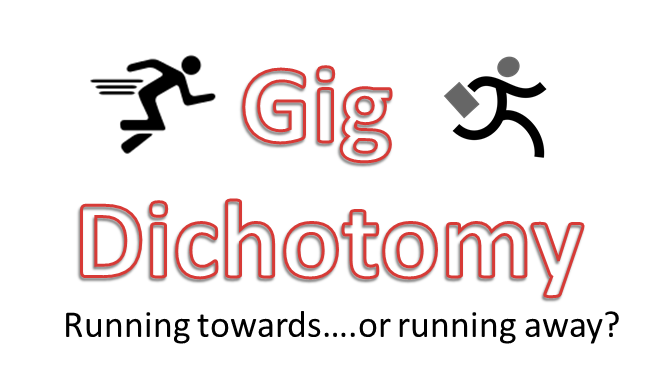 I was working my way through the Horizon 2 transition concepts for After Capitalism when a wonderful listserv conversation on the topic sprung up on APF on the gig economy. To set the debate:
I was working my way through the Horizon 2 transition concepts for After Capitalism when a wonderful listserv conversation on the topic sprung up on APF on the gig economy. To set the debate:
• supporters suggest the gig economy represents greater flexibility and freedom of choice;
• critics suggest it is a way for companies to save money with less pay and benefits.
I suspect most of us are in the middle – seeing the good and the bad.
The murkiness comes from the problem of defining just what a gig is. [reminds me of a favorite lament: many of world’s problems originate in vocabulary]. Looking at estimates of the gig economy, the GAO put it at 30% today, using a broad definition. I recall seeing a survey by Intuit in the spring that put it at 34%. At the conservative end of the spectrum, a synthesis of “high quality” studies put it at 11%. One almost laughable estimate by the BLS put it at 3.8%. Huh? Definitions…right!
My guess is that most studies will tend to be safe and under-estimate, so I’d lean towards 1/3rd of the workforce. It’s a fun argument, but let’s move on. The interesting question is whether it’s a good or bad thing. One academic study came out pretty strong on the bad, “cutting costs and avoiding benefits” as the primary motivation. There were lots of glowing reports, in the sorta techie hipster space. Of course, we can almost always find a study to support our preferred view if we have one, so we must use our analytical and perhaps intuitive skills to interpret the various studies.
Here’s three things I feel pretty confident about:
1. There will be more gigging in the future (regardless of motivation)
2. There is and will continue to be a great deal of cost-cutting and benefit avoidance motivated gigging “quietly” going on (again, the “pro” side is much louder)
3. While some love the freedom of the gig world, my money is on more giggers wishing they had a “real” job.
I think #3 deserves some explanation. A key concept is one’s sense of “existential security,” that is a relative sense that one’s survival is secure enough that it can be taken for granted. This is a key concept suggested Professor Ronald Inglehart of the World Values Survey explaining values shift. Basically, when one feels a high degree of existential security, they are more willing to “risk” a move to new values. When threatened, we go back to the familiar. I think that explains the Gig Dichotomy: those with a high degree of existential security love it; those with less existential security don’t.
This is important to After Capitalism in that the opportunity of the Visions is in providing that existential security. It’s foundational to all of the experimental new stuff. Only a small hardcore will try the truly new without that existential security. And today I suspect existential security is not at a high point!
What do think? Be glad to discuss! – Andy Hines

Hi Dr. Hines,
Thanks for the reference to our meta-survey at Nation1099. To clarity the point you paraphrased: We find that at least 11% of the U.S. workforce is full-time freelance in lieu of a W-2 job. (Another 4 percent are primarily 1099 but working less than full-time.) We arrive at that using the same studies that say 35 or 36 percent of the workforce is involved in the gig economy at least occasionally, Put another way, about 20 percent of the workforce are W-2 workers who are side hustling or moonlighting sometimes. The 11 percent figure and the 34 percent figure aren’t in conflict with one another. The first is a segment of the second.
I encourage readers not to dismiss 11 percent as a small share of the workforce. If it were an industry, that 11 percent of the workforce would be comparable to other sectors like government, education, manufacturing and healthcare. If all those workers were counted as under a single employer, “self-employed” would be the biggest single employer in the country.
Regarding point #2, it may be that employers have an incentive to encourage the growth of the gig economy, but the data shows that most full-time freelancers go into it willingly. The main drivers of the growth of freelancing are a demand for flexible work options, remote work options and a better work-life balance than is greater than the supply. Employers aren’t keeping up with what workers want. It’s possible that pent-up demand has always been there and that new technology (video conferencing, gig matching platforms and dynamically priced business operations software) are releasing it. In that case, perhaps a plateau in the growth of freelancing is coming. For now, though, the freelance workforce is growing four times faster than the overall workforce, and about a third of the active side hustlers say they want to make a complete transition to a 1099 career in the next year.
As for your third point: it seems to assume an equivalence between employment and a sense of security. I think a case could be made that a lot of employed workers and former W-2s don’t perceive that equivalence. Freelancers definitely express a lot of anxiety in surveys about income variability, retirement savings and healthcare costs. So do W-2 workers. One survey showed that freelancers experience more income security than they did in their last W-2 role.
That said, gig-based employment is obviously not an unalloyed good for everyone. My own theory is that there are three factors that determine if this is a net plus for an individual worker:
– How valued are the skills in the marketplace? Lousy jobs make for lousy gigs. People in high-demand jobs often thrive when they go independent.
– Full-time vs. part-time. People doing it part-time are more likely to be compelled to do it for extra income. Full-time freelancers are more likely to feel engagement with and passion for the work they’re doing.
– Tenure. Two years seems to be the transition point when freelancers start to meet their income goals and to see it a career they want to commit to.
-Robert McGuire
Thanks for clarifying the relationship of the 11% and 34% — makes good sense.
I hear you on 11% being a lot of people. I’ve had some conversations where people expected it to be much higher, thus it “seems” low – the 34% is probably where most people’s heads are at.
On #2, I may have put too much credence on Friedman’s 2014 piece that came out on the employers looking to cost cost side.Clearly, I need to dig into your full report and weigh the evidence more carefully.
on the existential security, I hear you, but not yet ready to give up on that yet :-). That said, I’m taking a rather brisk look at the gig phenomena as part of other work, whereas y’all have done the deep drill. So, dear readers, take note of that!!!
Really good stuff, Robert, thanks!
wow, thanks so much for your thoughtful and helpful response — wonderful! I’d like to reflect a bit before commenting further, but I generally agree with what you’ve added and think brought some important new light to the discussion.